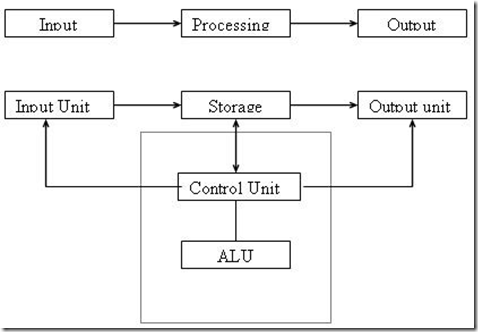We read about DDR2, DDR3 RAMs and such, given in every computer/laptop configuration. But have we ever bothered to find out what it actually means?
Many people brag about having 8 – 16 GB RAMs but in fact very few people know what exactly it does. We generally seem to think that higher the RAM, greater the speed. Actually, with emerging new technologies, that’s not necessarily the case. *
Like my other “how stuff works” posts, this is aims to general public and doesn’t go about specifics (mostly).
What is a RAM?
I actually want to explain this in a designers perspective (engineers rock!). Here’s a simple block diagram from my Electronics textbook. Look at it once.
When we tell storage, Hard drives come in to picture. Does this block diagram portray RAM? Just storage right? Now, I make a crappy statement that for a computer to work RAM is not needed. Say you’re a designer designing a computer. I have a processor, a hard drive, input output devices. Hard disk to read information, rotate and pin point (this is the right word) a sector and read it. Kinda like grahamaphone. Problem is that, this process is very slow. So, if I make a computer with just these components, Whatever be the processor speed, to read my information, I’m handicapped with the hard drive’s transfer speed. So, my computer will be as slow as the hard drive.
Now, you are give a brand new technology (lets call it RAM tech) whose transfer speed is super fast but they are very expensive. For commercial viability, we need cheaper goods. So, what you do is place the RAM inbetween the hard drive and the output. So, as soon as the processor dumps the processed data into your super fast RAM, the output is given to the computer screen. When you are not working with your computer, maybe to lift a dropped pen, the computer copies the output to your hard drive from your RAM. Some processes like visual rendering, don’t even do that. So, you need a lot of RAM to play games. RAM is like a buffer memory. Following is the basic idea of a cache.
With more RAM, you can dump more processed data, you can open a lot more tabs on your google chrome and still not freeze. When you exceed the RAM storage, you’re computer freezes. Freeze = hard drive speed. So, imagine a computer without RAM ;). So, yes, more RAM means More speed because you can hold a lot more temporary data.
* Now justifying my previous statement. Now Mr. designers gets another technology with twice the bus speed (say RAM tech2). You process some 3D model and get it on the screen. As this process is fast, the queuing of other processes will come down. So, temporary data can be deleted faster. Needing less memory to get the same experience. So, faster the bus speed means you can get your data faster so needing less memory.
Hope, I haven’t confused you. This is the difference between DDR2 and DDR3. DDR3 is almost twice as fast as DDR2. So, 2 GB DDR3 is equivalent to 4 GB DDR2. There are variants with different speeds of the same technology. DDR2 and DDR3 are not compatible with each other.
Also, there is this swap partitions. Also called as Virtual Memory in Windows. You can partition your hard drive to swap temporary data with the RAM and your Hard Drive when your RAM is running low. This helps if you want to open up a lot of tabs and applications. Though, this would not affect your graphic performance, it will stabilize your computer.
I have a lot of money, I can afford a Hard Disk sized RAM, Would that work?
At the end of the day, its memory. So, yes. Some Live environments (like Ubuntu, BartPE) use RAM as storage space. That’s why Ubuntu Live needs atleast 512 MB RAM. But obviously, you can’t live on 512 MB.
Commercially, these new age SSD (solid state drives) flash technology was used as RAM technologies 10-15 years backs. As expected, SSDs are super fast storage equipments as they have no moving parts and expensive. no wonder, MacBooks are fast!
However, RAMs aren’t ultimate. They are designed to forget stuff once you switch your PC off. So, in the end, speed comes at a cost.
All this is complicated tech. You have many types of RAMs from basic SRAMs DRAMs to high tech DDR3s. If you want to learn even more, you’ll have to go to college (I’m looking forward to that)

